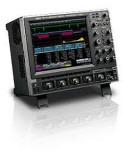22 Lý Tự Trọng, Minh Khai, Hồng Bàng, Hải Phòng.
itvc.haiphong@itvc-global.com
Chi tiết sản phẩm
Hãng sản xuất: Teledyne LeCroy - USA
Model: VBA104Xi-A
Analog Bandwidth:1 GHz
Single-Shot Sample Rate/Ch:5GS/s
Input Channels:4
Color 10.4" flat-panel TFT-LCD with high resolution touch screen
The Vehicle Bus Analyzer decodes CAN serial data into Symbolic (application layer ) text directly on the oscilloscope display. For the first time, an engineer has both the full range of CAN protocol stack information—symbolic, hex, and electrical signal—and the ability to view additional in-circuit electrical signals (sensors and actuators, voltage levels, transients, etc.) that influence the CAN bus. In addition, up to four different CAN buses can be decoded at one time.Standard and specialized oscilloscope tools can be used to validate and debug designs.
- CAN symbolic (Application Layer) decode of up to 4 CAN buses
- CAN triggering with setup in symbolic format
- CAN digital date extraction with symbolic format setup and plot data as an analog signal
- CAN automated timing measurements
- Compatible with CAN DBC database format
- Includes CANbus TDM, FlexRay TDP, and LINbus TD solutions
- FlexRay, Trigger, Decode, and Physical Layer testing (version 2.1)
- LIN Trigger and Decode supported for 1.3, 2.x, J2602 versions
- FlexRay eye diagram mask testing with error location
- FlexRay physical layer measurement para meters for propagation delay, asymmetric delay, truncation and jitter
- Capture thousands (seconds) of CAN, FlexRay and LINbus messages with up to 25 Mpts of memory
Direct symbolic decoding and triggering allows fast and intuitive understanding of events.Simply load your existing DBC database file into the oscilloscope (no re-entry of data is required); capture CAN message traffic; and all electrical (signal), protocol (hex), and symbolic (application) layer information is quickly displayed on the oscilloscope screen. Use standard oscilloscope and specialized Vehicle Bus Analyzer tools to find rare events, automatically measure and statistically analyze event timing, and graph/plot information, including extracted CAN message data.
The VBA concentrates all your information in one place. Timing measurements across gateways are now possible. Under standing is fast, intuitive, and in a familiar format. Complete, time-correlated understanding of all ECU or circuit behaviors is simple. Time-consuming workarounds are a thing of the past.
The VBA can make many measurements not possible with other instruments. Aside from timing measurements, the VBA can also extract CAN digital data from a CAN message stream, graphically plot that data as an analog signal on the oscilloscope display, and compare it to other electrical signals. Here, information on the steering angle and steering angle rate of change is extracted from the CAN message acquisition, rescaled to decimal values, and plotted as a time-correlated "Track" on the VBA display.
- Symbolic (application layer) decode of up to 4 separate CAN bus
- Symbolic CAN trigger setup
- Hexadecimal decode and trigger setup for CAN, FlexRay and LINbus.
- Binary trigger setup
-
Automated timing measurements, including capability to measure timing across gateways:
- CAN message to Analog signal
- Analog signal to CAN message
- CAN message to CAN message
- Bus Load % measurements (up to 2 billion events)
- CAN digital data extraction and display in analog form in scaled decimal values
- CAN message bit rate calculation
- Statistical calculations of many measurements
- Histogram (graphical) display of statistical data, including timing measurements
- Trend and Track plots of extracted CAN data
- Persistence trace, mean, and sigma functionality
- Complete set of Jitter and Timing (@level) parameters
- Supports for 2.5, 5, and 10 Mb/s FlexRay signals
- Physical layer measurement parameters for propagation delay, asymmetric delay, truncation and jitter for FlexRay
-
Vertical System
Analog Bandwidth @ 50 Ω (-3 dB) 1 GHz Rise Time (typical) 400 ps Input Connector ProBus/BNC Input Channels 4 Bandwidth Limiters 20 MHz; 200 MHz Input Impedance 1 MΩ || 20 pF or 50 Ω Input Coupling 50 Ω: DC, 1 MΩ: AC, DC, GND Maximum Input Voltage 50 Ω: 5 Vrms, 1 MΩ: 250 V max. (DC + Peak AC = 10 kHz) Vertical Resolution 8 bits; up to 11 with enhanced resolution (ERES) Sensitivity 50 Ω: 2 mV/div–1 V/div fully variable; 1 MΩ: 2 mV–10 V/div fully variable DC Gain Accuracy ±1.0% of full scale (typical); ±1.5% of full scale, = 10 mV/div (warranted) Offset Range ±400 mv@2–4.95 mv/div, ±1 V@5–99 mv/div, ±10 V @ 100 mv–1 V/div, ±100V @ 1.02–10 V/div; 1 M Ω: ±400 mv @ 2–4.95 mv/div, ±1 V @ 5–99 mv/div, ±10V @ 100 mv–1 V/div, ±100V @ 1.02–10 V/div Horizontal System
Timebases Internal timebase common to all input channels; an external clock may be applied at the auxiliary input Time/Division Range Real time: 200 ps/div–10 s/div, RIS mode: 200 ps/div to 10 ns/div, Roll mode: up to 1,000 s/div Clock Accuracy <= 5 ppm @ 25 °C (typical) (<= 10 ppm @ 5–40 °C) Sample Rate and Delay Time Accuracy Equal to Clock Accuracy Channel-Channel Deskew Range ±9 x time/div setting, 100 ms max., each channel External Clock DC to 600 MHz; (DC to 1 GHz for 104Xi and 204Xi) 50 Ω, (limited BW in 1 MΩ), BNC input, limited to 2 Ch operation (1 Ch in 62Xi), (minimum rise time and amplitude requirements apply at low frequencies) Roll Mode User selectable at = 500 ms/div and = 100 kS/s Acquisition System
Single-Shot Sample Rate/Ch 5 GS/s Random Interleaved Sampling (RIS) 200 GS/s Maximum Trigger Rate 1,250,000 waveforms/second Intersegment Time 800 ns Interleaved Sample Rate (2 Ch) 10 GS/s RIS Mode User selectable from 100 ps/div to 10 ns/div Acquisition Memory Options Max. Acquisition Points (4 Ch/2 Ch, 2 Ch/1 Ch in 62Xi) Segments (Sequence Mode) Acquisition Memory Options - Standard (4 Ch / 2Ch) 12.5M/25M 10,000 Sequence Time Stamp Resolution 1 ns Acquisition Processing
Averaging Summed and continuous averaging to 1 million sweeps Enhanced Resolution (ERES) From 8.5 to 11 bits vertical resolution Envelope (Extrema) Envelope, floor, or roof for up to 1 million sweeps Interpolation Linear or (Sinx)/x Time Resolution (min, Single-shot) 100 ps (10 GS/s) Triggering System
Trigger Modes Normal, Auto, Single, Stop Sources Any input channel, External, Ext/10, or Line; slope and level unique to each source, except Line Coupling DC, AC (typically 7.5 Hz), HF Reject, LF Reject Pre-trigger Delay 0–100% of memory size (adjustable in 1% increments, or 100 ns) Post-trigger Delay Up to 10,000 divisions in real time mode, limited at slower time/div settings in roll mode Hold-off by Time or Events 1 ns to 20 s or 1 to 1,000,000,000 events Internal Trigger Range EXT/10 ±4 V; EXT ±400 mV Trigger Sensitivity with Edge Trigger (Ch 1–4) 2 div @ < 1 GHz 1 div @ < 200 MHz Max. Trigger Frequency, SMART Trigger 1 GHz @ = 10 mV Basic Triggers
Edge Triggers when signal meets slope (positive, negative, or Window) and level condition. TV-Composite Video Triggers selectable fields (1, 2, 4, or 8), Positive or Negative slope, or Line (up to 1500), for NTSC, PAL, SECAM, or non-standard video (up to 1500 lines). SMART Triggers
State or Edge Qualified Triggers on any input source only if a defined state or edge occurred on another input source. Delay between sources is selectable by time or events. Dropout Triggers if signal drops out for longer than selected time between 1 ns and 20 s. Pattern Logic combination (AND, NAND, OR, NOR) of 5 inputs (4 channels and external trigger input – 2 Ch+EXT on WaveRunner 62Xi). Each source can be high, low, or don’t care. The High and Low level can be selected independently. Triggers at start or end of the pa SMART Triggers with Exclusion Technology
Glitch and Pulse Width Triggers on positive or negative glitches with widths selectable from 500 ps to 20 s or on intermittent faults (subject to bandwidth limit of oscilloscope). Signal or Pattern Interval Triggers on intervals selectable between 1 ns and 20 s. Timeout (State/Edge Qualified) Triggers on any source if a given state (or transition edge) has occurred on another source. Delay between sources is 1 ns to 20 s, or 1 to 99,999,999 events. Runt Trigger on positive or negative runts defined by two voltage limits and two time limits. Select between 1 ns and 20 s. Slew Rate Trigger on edge rates. Select limits for dV, dt, and slope. Select edge limits between 1 ns and 20 s. Exclusion Triggering Trigger on intermittent faults by specifying the normal width or period. Color Waveform Display
Type Color 10.4" flat-panel TFT-LCD with high resolution touch screen Resolution SVGA; 800 x 600 pixels; maximum external monitor output resolution of 2048 x 1536 pixels Number of traces Display a maximum of 8 traces. Simultaneously display channel, zoom, memory, and math traces. Grid Styles Auto, Single, Dual, Quad, Octal, XY, Single + XY, Dual + XY Waveform Representation Sample dots joined or dots only in real-time mode Internal Waveform Memory
Internal Waveform Memory M1, M2, M3, M4 Internal Waveform Memory (store full-length waveform with 16 bits/data point) or store to any number of files limited only by data storage media. LeCroy WaveStream™ Fast Viewing Mode
Intensity 256 Intensity Levels, 1–100% adjustable via front panel control Number of Channels up to 4 simultaneously Max Sampling Rate 5 GS/s (10 GS/s for WaveRunner 62Xi, 64Xi, 104Xi, 204Xi in interleaved mode) Waveforms/second (continuous) up to 8000 waveforms/second Operation Front panel toggle between normal real-time mode and LeCroy WaveStream Fast Viewing mode Zoom Expansion Traces
Zoom Expansion Traces Display up to 4 Zoom/Math traces with 16 bits/data point Setup Storage
Setup Storage Store to the internal hard drive, over the network, or to a USB-connected peripheral device. Interface
Remote Control Via Windows Automation, or via LeCroy Remote Command Set GPIB Port (optional) Supports IEEE – 488.2 Ethernet Port 10/100/1000Base-T Ethernet interface (RJ-45 connector) USB (Host) 5 USB 2.0 ports (one on front of instrument) supports Windows-compatible devices. External Monitor Port Standard 15-pin D-Type SVGA-compatible DB-15; connect a second monitor to use extended desktop display mode with XGA resolution. Serial Port DB-9 RS-232 port (not for remote oscilloscope control) Auxiliary Input
Signal Types Selected from External Trigger or External Clock input on front panel Coupling 50 Ω: DC, 1 MΩ: AC, DC, GND Maximum Input Voltage 50 Ω: 5 Vrms, 1 MΩ: 250 V max. (DC + Peak AC = 10 kHz) Auxiliary Output
Signal Types Trigger Enabled, Trigger Output. Pass/Fail, or Off Output Signal TTL, ˜3.3 V Calibrator Signal Output available on front panel connector provides a variety of signals for probe calibration and compensation. Automatic Setup
Auto Setup Automatically sets timebase, trigger, and sensitivity to display a wide range of repetitive signals. Find Vertical Scale Automatically sets the vertical sensitivity and offset for the selected channels to display a waveform with maximum dynamic range. General
Auto Calibration Ensures specified DC and timing accuracy is maintained for 1 year minimum. Power Requirements 90–264 Vrms at 50/60 Hz; 115 Vrms (±10%) at 400 Hz, Automatic AC Voltage Selection Installation Category: 300V CAT II; Max. Power Consumption: 340 VA/340 W; 290 VA/290 W for WaveRunner 62Xi Probes
Probes One PP007 per channel standard; Optional passive and active probes available. Probe System: ProBus Automatically detects and supports a variety of compatible probes. Scale Factors Automatically or manually selected, depending on probe used Environmental and Safety
Temperature (Operating) +5 °C to +40 °C Temperature (Non-Operating) -20 °C to +60 °C Humidity (Operating) Maximum relative humidity 80% for temperatures up to 31 °C decreasing linearly to 50% relative humidity at 40 °C Humidity (Non-Operating) 5% to 95% RH (non-condensing) as tested per MIL-PRF-28800F Altitude (Operating) Operating Up to 2,000 m Altitude (Non-Operating) Non-Operating 12,190 m Physical Dimensions
Dimensions (HWD) 260 mm x 340 mm x 152 mm Excluding accessories and projections (10.25" x 13.4" x 6") Net Weight 6.95 kg. (15.5 lbs.) Certifications
Certifications CE Compliant, UL and cUL listed; Conforms to EN 61326, EN 61010-1, UL 61010-1 2nd Edition, and CSA C22.2 No. 61010-1-04.



















